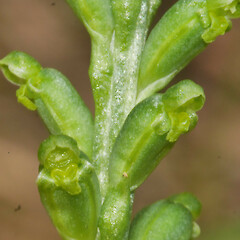Microtis parviflora
Common name
onion-leaved orchid
Synonyms
None
Family
Orchidaceae
Flora category
Vascular – Native
Endemic taxon
No
Endemic genus
No
Endemic family
No
Structural class
Orchids
NVS code
The National Vegetation Survey (NVS) Databank is a physical archive and electronic databank containing records of over 94,000 vegetation survey plots - including data from over 19,000 permanent plots. NVS maintains a standard set of species code abbreviations that correspond to standard scientific plant names from the Ngä Tipu o Aotearoa - New Zealand Plants database.
MICPAR
Chromosome number
2n = 44
Current conservation status
The conservation status of all known New Zealand vascular plant taxa at the rank of species and below were reassessed in 2017 using the New Zealand Threat Classification System (NZTCS) – more information about this can be found on the NZTCS website. This report includes a statistical summary and brief notes on changes since 2012 and replaces all previous NZTCS lists for vascular plants.
Please note, threat classifications are often suggested by authors when publications fall between NZTCS assessment periods – an interim threat classification status has not been assessed by the NZTCS panel.
- Conservation status of New Zealand indigenous vascular plants, 2017 . 2018. Peter J. de Lange, Jeremy R. Rolfe, John W. Barkla, Shannel P. Courtney, Paul D. Champion, Leon R. Perrie, Sarah M. Beadel, Kerry A. Ford, Ilse Breitwieser, Ines Schönberger, Rowan Hindmarsh-Walls, Peter B. Heenan and Kate Ladley. Department of Conservation. Source: NZTCS and licensed by DOC for reuse under the Creative Commons Attribution 4.0 International licence.
2017 | Not Threatened | Qualifiers: SO
Previous conservation statuses
2012 | Not Threatened
2009 | Not Threatened
2004 | Not Threatened
Distribution
Indigenous. New Zealand: Kermadec Islands, Manawatāwhi / Three Kings Islands, North Island (scarce south of Waikato and Bay of Plenty), South Island (Marlborough Sounds, North-west Nelson and the northern West Coast. Probably also in Australia.
Habitat
Coastal to lowland. Favouring open clay pans, sand dune hollows, and other areas of exposed soil with little overhead vegetation. Common in gumland scrub, on the margins of peat bogs, in seral forest and within geothermal fields.
Wetland plant indicator status rating
Information derived from the revised national wetland plant list prepared to assist councils in delineating and monitoring wetlands (Clarkson et al., 2021 Manaaki Whenua – Landcare Research Contract Report LC3975 for Hawke’s Bay Regional Council). The national plant list categorises plants by the extent to which they are found in wetlands and not ‘drylands’. The indicator status ratings are OBL (obligate wetland), FACW (facultative wetland), FAC (facultative), FACU (facultative upland), and UPL (obligate upland). If you have suggestions for the Wetland Indicator Status Rating, please contact: [Enable JavaScript to view protected content]
FAC: Facultative
Commonly occurs as either a hydrophyte or non-hydrophyte (non-wetlands).
Detailed description
Terrestrial, glabrous, colony forming, fleshy, tuberous bright green to yellow-green perennial herb. Plants at flowering 100–400–(700) mm tall. Tubers globose to ovoid. Stem erect, terete. Leaf solitary, usually overtopping inflorescence, bright green to yellow-green, closely sheathing stem for much of length, linear-terete, hollow, 400 × 8 mm long. Inflorescence a raceme up to 300 × 10 mm. Flowers 10–80, up to 3 mm diameter, shortly-stalked and closely spaced, more or less overlapping. Perianth green to yellow-green, segments up to 2.2 mm long, widely spreading, thick and fleshy. Dorsal sepal 1.5–2.0 mm long, ovate, erect or projecting forwards, cucullate, concave, column-embracing, acute, apex shortly recurved, smaller than ovary at flowering; lateral sepals shorter and narrower, subacute, strongly deflexed, usually curled under. Petals shorter still, narrowly obtuse, erect, usually partially hidden under dorsal sepal. Labellum sessile, tongue-like, up to 2 mm long, green or yellow-green, more or less triangular-cordate, decurved but more less slightly projecting forwards, broader at base narrowing to an obtuse apex terminated by a down-turned apiculus; margin entire to sinuate (with marginal cells occasionally, slightly enlarged), smooth; anterior callus usually present, somewhat variable in size; basal calli prominent, dark green, ovate, paired and parallel, surrounding a distinct small pouched bulge on the under side of the labellum. Column short, obtuse, base of column wider than stigma, otherwise narrowing behind stigma, wings membranous throughout. Anther terminal, erect, situated above stigma, hemispherical, pollinia spheroidal, pollen granular. Stigma broadly ovate; rostellum ovate. Capsules broadly ovoid, ovoid-ellipsoid, brown when ripe.
Manaaki Whenua Online Interactive Key
Similar taxa
Easily distinguished from M. unifolia (G.Forst.) Reichb.f. and M. oligantha L.B.Moore by the more or less triangular labellum, which narrows abruptly to a down-turned apiculate tip, has a pouched base and an almost entire or smooth margin.
Flowering
September–March
Flower colours
Green, Yellow
Fruiting
December–May
Propagation technique
Easily grown in a sunny position. Should not be removed from the wild. Often invades urban lawns inm palces adjacent to gum land scrub (such as in western Auckland).
Etymology
microtis: Tiny eared
parviflora: From the Latin parvus ‘small, puny’ and flores ‘flowers’, meaning small-flowered.
Where To Buy
Not commercially available
TAXONOMIC NOTES
New Zealand plants refered to M. parviflora are possibly distinct and may warrant separate taxonomic recognition. It is not clear if they are endemic, and at this stage NZPCN has assumed that they are not.
Attribution
Fact Sheet prepared for NZPCN by P.J. de Lange 14 April 2007. Description adapted from Moore and Edgar (1970).
References and further reading
Moore LB, Edgar E. 1970. Flora of New Zealand, Volume II. Indigenous Tracheophyta: Monocotyledones except Gramineae. Government Printer, Wellington, NZ. 354 p.
NZPCN Fact Sheet citation
Please cite as: de Lange, P.J. (Year at time of access): Microtis parviflora Fact Sheet (content continuously updated). New Zealand Plant Conservation Network. https://www.nzpcn.org.nz/flora/species/microtis-parviflora/ (Date website was queried)





